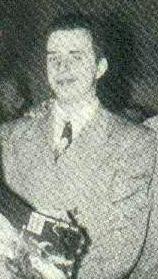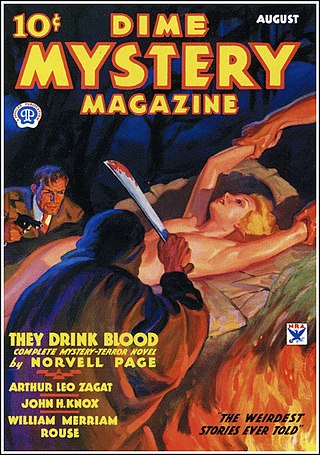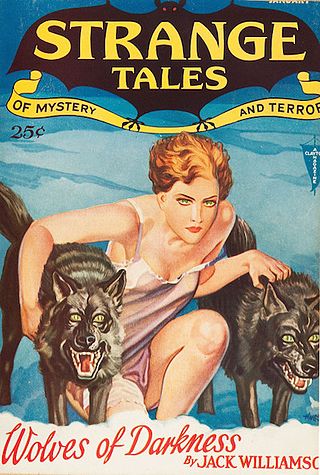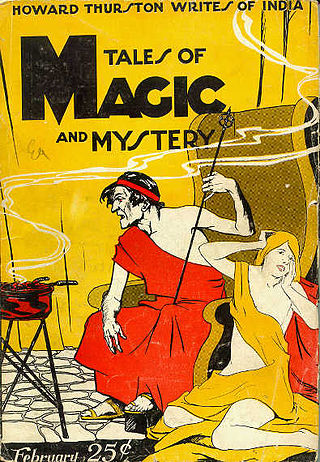Related Research Articles
Pulp magazines were inexpensive fiction magazines that were published from 1896 until around 1955. The term "pulp" derives from the cheap wood pulp paper on which the magazines were printed. In contrast, magazines printed on higher-quality paper were called "glossies" or "slicks". The typical pulp magazine had 128 pages; it was 7 inches (18 cm) wide by 10 inches (25 cm) high, and 0.5 inches (1.3 cm) thick, with ragged, untrimmed edges. Pulps were the successors to the penny dreadfuls, dime novels, and short-fiction magazines of the 19th century.

Weird Tales is an American fantasy and horror fiction pulp magazine founded by J. C. Henneberger and J. M. Lansinger in late 1922. The first issue, dated March 1923, appeared on newsstands February 18. The first editor, Edwin Baird, printed early work by H. P. Lovecraft, Seabury Quinn, and Clark Ashton Smith, all of whom went on to be popular writers, but within a year, the magazine was in financial trouble. Henneberger sold his interest in the publisher, Rural Publishing Corporation, to Lansinger, and refinanced Weird Tales, with Farnsworth Wright as the new editor. The first issue to list Wright as editor was dated November 1924. The magazine was more successful under Wright, and despite occasional financial setbacks, it prospered over the next 15 years. Under Wright's control, the magazine lived up to its subtitle, "The Unique Magazine", and published a wide range of unusual fiction.

Frank Belknap Long Jr. was an American writer of horror fiction, fantasy, science fiction, poetry, gothic romance, comic books, and non-fiction. Though his writing career spanned seven decades, he is best known for his horror and science fiction short stories, including contributions to the Cthulhu Mythos alongside his friend, H. P. Lovecraft. During his life, Long received the World Fantasy Award for Life Achievement, the Bram Stoker Award for Lifetime Achievement, and the First Fandom Hall of Fame Award (1977).
George H. Scithers was an American science fiction fan, author and editor.

Donald Albert Wandrei was an American science fiction, fantasy and weird fiction writer, poet and editor. He was the older brother of science fiction writer and artist Howard Wandrei. He had fourteen stories in Weird Tales, another sixteen in Astounding Stories, plus a few in other magazines including Esquire. Wandrei was the co-founder of the prestigious fantasy/horror publishing house Arkham House.
John Gregory Betancourt is an American writer of science fiction, fantasy and mystery novels, as well as short stories. He is also known as the founder and publisher, with his wife Kim Betancourt, of Wildside Press in 1989. In 1998, they entered the print on demand (PoD) market and greatly expanded their production. In addition to publishing new novels and short stories, they have undertaken projects to publish new editions of collections of stories that appeared in historic magazines.
Farnsworth Wright was the editor of the pulp magazine Weird Tales during the magazine's heyday, editing 179 issues from November 1924 to March 1940. Jack Williamson called Wright "the first great fantasy editor".

Darrell Charles Schweitzer is an American writer, editor, and critic in the field of speculative fiction. Much of his focus has been on dark fantasy and horror, although he does also work in science fiction and fantasy. Schweitzer is also a prolific writer of literary criticism and editor of collections of essays on various writers within his preferred genres.

Robert Augustine Ward "Doc" Lowndes was an American science fiction author, editor and fan. He was known best as the editor of Future Science Fiction, Science Fiction, and Science Fiction Quarterly, among many other crime-fiction, western, sports-fiction, and other pulp and digest sized magazines for Columbia Publications. Among the most famous writers he was first to publish at Columbia was mystery writer Edward D. Hoch, who in turn would contribute to Lowndes's fiction magazines as long as he was editing them. Lowndes was a principal member of the Futurians. His first story, "The Outpost at Altark" for Super Science in 1940, was written in collaboration with fellow Futurian Donald A. Wollheim, uncredited.
Robert Edward Weinberg was an American author, editor, publisher, and collector of science fiction. His work spans several genres including non-fiction, science fiction, horror, and comic books.

Weird menace is a subgenre of horror fiction and detective fiction that was popular in the pulp magazines of the 1930s and early 1940s. The weird menace pulps, also known as shudder pulps, generally featured stories in which the hero was pitted against sadistic villains, with graphic scenes of torture and brutality.

Marvin Nathan Kaye was an American mystery, fantasy, science fiction, and horror author, anthologist, and editor. He was also a magician and theater actor. Kaye was a World Fantasy Award winner and served as co-publisher and editor of Weird Tales Magazine.

Arthur Leo Zagat (1896–1949) was an American lawyer and writer of pulp fiction and science fiction. Trained in the law, he gave it up to write professionally. Zagat is noted for his collaborations with fellow lawyer Nat Schachner. During the last two decades of his life, Zagat wrote short stories prolifically. About 500 pieces appeared in a variety of pulp magazines, including Thrilling Wonder Stories, Argosy, Dime Mystery Magazine, Horror Stories, Operator No. 5 and Astounding. Zagat also wrote the "Doc Turner" stories that regularly appeared in The Spider pulp magazine throughout the 1930s and the "Red Finger" series that ran in Operator #5, and wrote for Spicy Mystery Stories as "Morgan LaFay". A novel, Seven Out of Time, was published by Fantasy Press in 1949, the year he died. His more well known series is probably the Tomorrow series of 6 novelettes from Argosy collecting into 2 volumes by Altus Press in 2014.
Keith John Taylor is an Australian science fiction and fantasy writer.

Famous Fantastic Mysteries was an American science fiction and fantasy pulp magazine published from 1939 to 1953. The editor was Mary Gnaedinger. It was launched by the Munsey Company as a way to reprint the many science fiction and fantasy stories which had appeared over the preceding decades in Munsey magazines such as Argosy. From its first issue, dated September/October 1939, Famous Fantastic Mysteries was an immediate success. Less than a year later, a companion magazine, Fantastic Novels, was launched.
DNA Publications was an American publishing company that existed from 1993 to 2007 and was run by the husband-and-wife team of Warren Lapine and Angela Kessler. Initially based in Massachusetts, DNA Publications relocated to Radford, Virginia. As of 2004, it was the second-largest genre magazine publisher in the United States. Its first publication, in 1993, was the magazine Harsh Mistress, which Lapine produced in collaboration with Kevin Rogers and Tim Ballon.

The Robert E. Howard Reader is a collection of essays on fantasy writer Robert E. Howard and his works, edited by Darrell Schweitzer. Originally scheduled for publication in 2007, it was ultimately published in September 2010 by Wildside Press.

Strange Tales was an American pulp magazine first published from 1931 to 1933 by Clayton Publications. It specialized in fantasy and weird fiction, and was a significant competitor to Weird Tales, the leading magazine in the field. Its published stories include "Wolves of Darkness" by Jack Williamson, as well as work by Robert E. Howard and Clark Ashton Smith. The magazine ceased publication when Clayton entered bankruptcy. It was temporarily revived by Wildside Press, which published three issues edited by Robert M. Price from 2003 to 2007.

Tales of Magic and Mystery was a pulp magazine which published five monthly issues from December 1927 to April 1928. It was edited by Walter Gibson, and published a mixture of fiction and articles on magic. It is now mainly remembered for having published a story by H.P. Lovecraft.

Science-fiction and fantasy magazines began to be published in the United States in the 1920s. Stories with science-fiction themes had been appearing for decades in pulp magazines such as Argosy, but there were no magazines that specialized in a single genre until 1915, when Street & Smith, one of the major pulp publishers, brought out Detective Story Magazine. The first magazine to focus solely on fantasy and horror was Weird Tales, which was launched in 1923, and established itself as the leading weird fiction magazine over the next two decades; writers such as H.P. Lovecraft, Clark Ashton Smith and Robert E. Howard became regular contributors. In 1926 Weird Tales was joined by Amazing Stories, published by Hugo Gernsback; Amazing printed only science fiction, and no fantasy. Gernsback included a letter column in Amazing Stories, and this led to the creation of organized science-fiction fandom, as fans contacted each other using the addresses published with the letters. Gernsback wanted the fiction he printed to be scientifically accurate, and educational, as well as entertaining, but found it difficult to obtain stories that met his goals; he printed "The Moon Pool" by Abraham Merritt in 1927, despite it being completely unscientific. Gernsback lost control of Amazing Stories in 1929, but quickly started several new magazines. Wonder Stories, one of Gernsback's titles, was edited by David Lasser, who worked to improve the quality of the fiction he received. Another early competitor was Astounding Stories of Super-Science, which appeared in 1930, edited by Harry Bates, but Bates printed only the most basic adventure stories with minimal scientific content, and little of the material from his era is now remembered.
References
- ↑ "diamondbookdistributors.com - Publishers". www.diamondbookdistributors.com. Retrieved May 10, 2020.
- 1 2 "Cosmos Books / Wildside Press - Bibliography". ISFDB.org. Retrieved March 10, 2015.
- ↑ "Audiobooks and CDs". Wildside Press. Retrieved August 19, 2015.
- ↑ "Home page metadata for Home page". wildsidepress.com. Retrieved August 19, 2015.
- ↑ Scithers, George H., ed. (September 1, 2008). Cat Tales: Fantastic Feline Fiction (paperback ed.). Wildside Press. ASIN B00CC4382O.
- ↑ Scithers, George H., ed. (April 16, 2010). Cat Tales 2: Fantastic Feline Fiction (1st ed.). Wildside Press. ISBN 978-1434409126.
- ↑ "Freebies". Wildside Press.